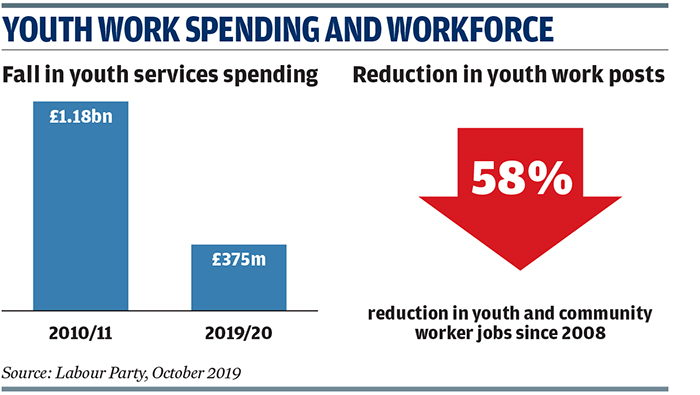Priorities for the youth fund
Derren Hayes
Tuesday, October 29, 2019
Three youth work experts outline how the government's £500m youth investment fund should be spent.
At the Conservative Party conference, Chancellor Sajid Javid announced government plans to establish a new Youth Investment Fund backed by £500m over five years.
The Department for Digital, Culture, Media and Sport said the fund will help build 60 new youth centres and refurbish 360 existing facilities. It also committed to providing more than 100 mobile youth centres for harder to reach areas.
In addition, the department said the fund will also support the provision and co-ordination of high-quality services for young people, and an investment in the youth workforce.
The announcement - which expanded on plans in September's one-year Spending Round - has been broadly welcomed by the sector, although some have highlighted that the funding does not fully offset cuts in youth work spending.

Latest analysis by YMCA England and Wales suggests councils spending on youth services has fallen 69 per cent since 2010 and now stands at its "lowest level in a generation".
Meanwhile, analysis by Labour suggests government spending on youth services has fallen by £1bn in real terms between 2010/11 and 2019/20, resulting in 14,500 youth work jobs being lost.
Set against this backdrop, three youth work experts set out where they think the new investment should be prioritised.
Distribute cash quickly
By Anna Smee, chief executive, UK Youth
Figures released this year by the all-party parliamentary group on knife crime showed that more than 100 councils have had up to 91 per cent of their youth services budgets cut, and that areas suffering the largest cuts have seen greater increases in knife crime.
The overall level of happiness young people feel in their lives has flatlined at its lowest ever, according to the Prince's Trust, and eight in 10 young people we surveyed believe they will never be financially secure.
Services have reached desperate levels of under-funding. It is crucial this investment is distributed quickly and efficiently to organisations with strong community connections. Further, investment must be co-ordinated at a national level by, or in partnership with, UK Youth so local organisations have access to peer support, knowledge sharing, impact measurement and policy influencing opportunities. Together we can ensure local provision is provided for the next generation.
The majority of the 5,500 organisations that make up the UK Youth movement say the focus should be on providing positive activities for young people, reopening closed and renovating existing youth clubs. It is vital we ensure this money goes to where the sector needs it to support the maximum number of young people.
Invest in youth workers
By Leigh Middleton, chief executive, National Youth Agency
How far will this money stretch? If half is spent on capital projects, the remaining £50m a year for youth work covers just five per cent of the revenue income cut from youth services. There is a critical need to invest in youth centres, clubs and safe spaces for young people in their communities. Yet to run such provision and extend services to reach all young people requires skilled youth workers.
Any investment should underpin guaranteed access to quality youth services and community-based provision. Therefore NYA is calling for a census as the first step towards longer-term, sustainable funding. This can be prepared and carried out as part of the Spending Review, so not to slow down early funding commitments.
We recognise it is hard to attract consistent funding for youth work to take place beyond short-term programmes. The guiding principles should be: invest in people not simply buildings, where professional skills and training can be applied to best affect, working with young people directly; sustain those trusted relationships with core funding and involve young people in decision-making; refurbish facilities run by agencies - with young people; and set up a local youth partnership, including better links between schools and agencies.
Say for local groups
By Judith Blake, chair, LGA children and young people board
We all want young people to thrive and reach their full potential as they transition to adulthood, but councils' ambitions to help them do this have been hit by funding cuts.
Local authorities in England and Wales have been forced to reduce spending on youth services by 52 per cent between 2010/11 and 2017/18, and 600 youth centres have closed since 2012.
Councils want to work with the government to ensure the £500m pledged by the Chancellor is spent in the best possible ways for young people in different areas and ensure positive outcomes. Any new provision must be integrated with what already exists to make sure we're creating a joined-up system that works for young people.
Local decision makers and young people know best how the money should be spent to meet different needs in different areas, so it's vital they have a say. To future-proof any plans, we need to ensure we're training enough youth workers to support new youth centres, with a guarantee of ongoing money to run activities. We don't want to end up with empty youth clubs or short-lived offers.
This money is a great start, but we urge the government to build on this in next year's Spending Review to ensure we can offer young people the long-term investment they deserve.




